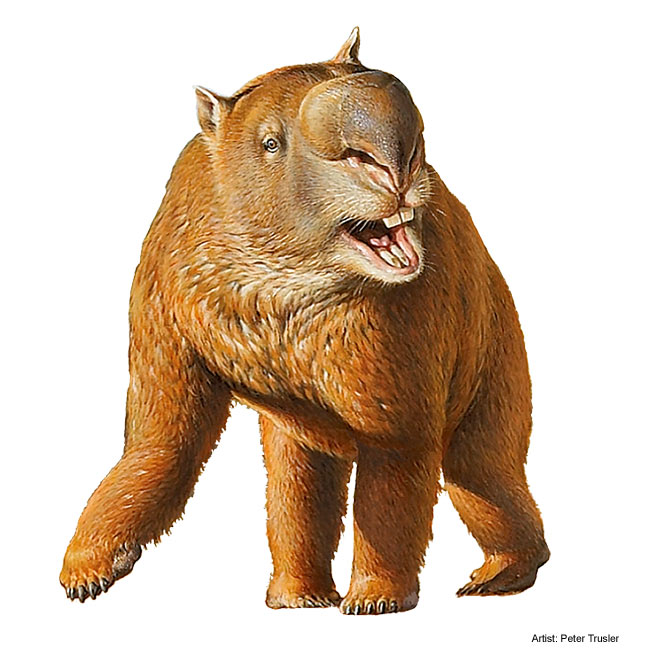
The Bunyip is a creature from Australian Aboriginal mythology, said to lurk in swamps and riverbeds. Over the years, the description has varied wildly from a water spirit in the form of a starfish to a large black animal like a seal with fangs. But where did this creature come from?

The bunyip was part of traditional Aboriginal beliefs and stories throughout Australia, though it changes by region. The word bunyip most commonly translates to “devil” or “evil spirit.”
Images of these strange beasts have appeared in Aboriginal drawings across the continent. Europeans recorded various written accounts of the animal as they began settling the country.

The Challicum Bunyip is considered to be the outline of the animal carved by the native people into the banks of Fiery Creek. Reports say in 1851, the bunyip came from the water and killed an Aboriginal man. The community then speared the creature. The outline no longer remains.
Throughout the Victorian era, sightings of the creature increased. The creature was described one of two ways. Most stated the Bunyip resembled seals or dogs around 6 feet long with shaggy brown coats. The others described the creature as being up to 15 feet long, with black fur, small tusks, and a long neck like an emu.
The Bunyip was thought to be able to swim swiftly and see in the dark.

While many people think that the Bunyip was created from seals making their way up the riverway, others believe that the bunyip may be cultural memory of an extinct marsupial called the Diprotodon.
This connection was originally made by Dr. George Bennett of the Australian Museum in 1871. In the 1990’s, paleontologist Pat Vickers-Rich suggested the legends perhaps stemmed from an acquaintance with prehistoric skeletons or even the living creatures.

Diprotodon is an extinct genus of marsupials native to Australia, thriving during the Pleistocene (Ice Age). It is considered the largest marsupial to ever have existed. Diprotodon went extinct some 44,000 years ago after the initial settlement of the continent. Scientists debate whether human and climatic factors contributed to their extinction.
The creature is known from sites across mainland Australia. The largest specimens were hippo-sized, standing 6.5 ft tall and weighting over 3 tons.

Diprotodon is usually compared to a large wombat. In fact it is considered a distant relative of wombats and koalas. Like its relatives, it had two forward-projection teeth that stuck from its mouth like tusks. It had a large skull with an unusually large nasal. This suggested either a large nose or a tapir-like trunk. It was quadrupedal and browsed plant material.
The creature was known from across the continent, but could be coastal regions. While the Diprotodon had the anatomy to feed on shrubs and forbs, others in the family could be found near rivers and the coast. These animals could be found basking in watering holes – much like elephants.
Unlike elephants, marsupials do not move in herds. It is likely that lone individuals or small groups could be found near waterholes.

The Aboriginal peoples and the Diprotodon would have crossed paths. Australia was originally settled approximately 58,000 years ago. By that time, the Diprotodon would have established itself into the wilds of the continent. As the Aboriginal people spread, they would have come into contact with this ferocious looking beast. Stories spread between tribes sparking the idea of this monster. As time passed, the legend of the Bunyip was passed down through generations with its origins murky.
Sources:
https://australian.museum/learn/australia-over-time/extinct-animals/diprotodon-optatum/
https://www.britannica.com/animal/Diprotodon
http://anomalyinfo.com/Stories/1851-pre-challicum-bunyip
Holden, Robert (2001), Bunyips: Australia’s folklore of fear, National Library of Australia.
Eberhart, George M. (2002). Mysterious Creatures: A Guide to Cryptozoology. pp. 74–77.
Price, G.J. (June 2008). “Taxonomy and palaeobiology of the largest-ever marsupial, Diprotodon Owen, 1838 (Diprotodontidae, Marsupialia)”. Zoological Journal of the Linnean Society. 153 (2): 369–397.
Roberts, R.G.; Flannery, T.F.; Ayliffe, L.K.; Yoshida, H.; Olley, J.M.; Prideaux, G.J.; et al. (8 June 2001). “New ages for the last Australian megafauna: Continent-wide extinction about 46,000 years ago” (PDF). Science. 292 (5523): 1888–1892.